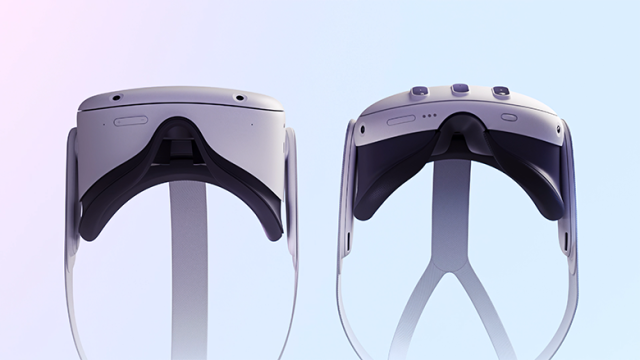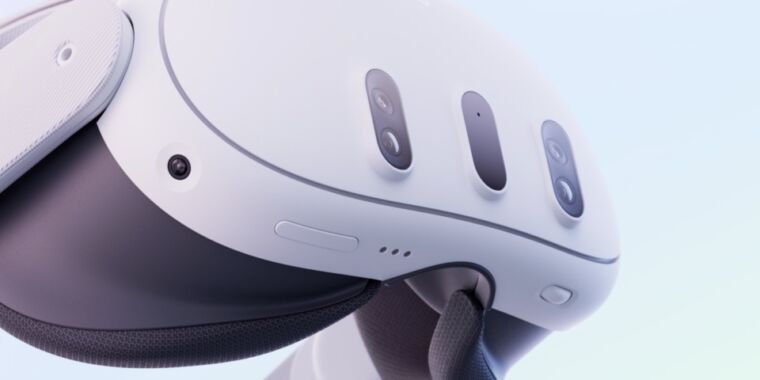Meta
You’d be forgiven for not realizing that the Quest 3 is actually the fourth headset in Meta’s popular Quest line. In fact, Meta would probably prefer that everyone forget about last year’s ill-considered Quest Pro, which paired a handful of minor improvements with an absolutely massive $1,500 starting price. Even a quick price drop to $1,000 couldn’t save this over-engineered stopgap gadget.
What a difference a year makes—or three years, for VR aficionados who wisely stuck with 2020’s Quest 2 until now. The Quest 3 offers distinct improvements over previous Quest headsets in the areas that matter most (resolution, form factor, etc.) without many of the Pro’s more expensive, heavy, and least necessary indulgences (eye-tracking cameras, rechargeable controllers, charging dock, etc.). The Quest 3 also offers a usable (but rough) suite of new mixed-reality features, providing an intriguing glimpse of a world where VR content is routinely layered over our view of reality.
Most importantly, the Quest 3 does this all at a mass-market price (starting at $500) and in a way that ensures continuity with Quest’s existing software. While there’s nothing here that will usher in the long-sought virtual reality revolution, this is the kind of incremental improvement the space needs if it’s going to continue to increase the size of its niche.
The most comfortable Quest yet
At first glance, the physical design of the Quest 3 doesn’t look like it should lead to a different fit and feel than the similar-looking Quest 2. After spending a good deal of time in the new headset, though, I was surprised at just how much more comfortable it was for long sessions.
Much of this comes down to the Quest 3’s use of lenses with pancake optics, which allow for a much thinner display housing that rests in front of your eyes. This redistributes the weight of the headset much closer to your face, which means the center of mass doesn’t pull your head forward nearly as much. This rebalancing also means a headset with roughly the same weight as the Quest 2 can sit securely on your face without the need to tighten the head strap in a death grip around your skull, leading to noticeably less pressure on the area around your eyes and sinuses.

Speaking of the head strap, the redesigned one that comes with the Quest 3 is a huge improvement over the flimsy thing that was packaged with the Quest 2. The new design offers good, firm support for the headset’s weight with just enough elasticity to stretch a bit around your skull as you put it on. I’m also a fan of the new fit adjustment system on the back of the strap, which allows for loosening and tightening by gently sliding two bits of gently grippy fabric to either side.
Altogether, these changes make for a much more comfortable experience than wearing the Quest 2 (which I always felt was threatening to slip off my head when I used its original head strap). I’ve used the Quest 3 for numerous multi-hour sessions without any significant discomfort or eyestrain, especially for less active (e.g., seated) situations.
The design still presents some problems during VR workouts, though, where the lens housing traps heat and moisture in a way that leaves the front of my face drenched in sweat after even moderate activity. During these exercise sessions, I missed the open-bottomed, forehead-mounted design of the Quest Pro, which allows for free airflow across more of the face.
